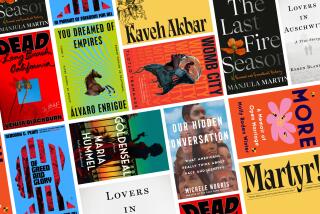FIRST FICTION
The Dogs of Babel
Carolyn Parkhurst
Little, Brown: 266 pp., $21.95
“They sit on the laps of presidents. They see acts of love and violence, quarrels and feuds and the secret play of children. If they could tell us all they have seen, all of the gaps of our lives would stitch themselves together.” This is the quixotic hope of Paul Iverson, the grief-stricken linguistics professor who narrates “The Dogs of Babel,” an irresistible shaggy dog story from Carolyn Parkhurst. Paul is talking about man’s best friend, in particular a Rhodesian Ridgeback named Lorelei, the sole witness to the death of his high-strung wife, Lexy. Did Lexy accidentally fall from that apple tree in the backyard? Or was she trying to do herself in? Only Lorelei knows. But how to extract this vital pathological evidence from the faithful family hound?
Rationalist that he is, Paul determines to teach Lorelei how to speak English, thus embarking on a bizarre sublimation of grief. His investigation into canine language acquisition is a cover for a much stickier research project: a thorough account of Lexy, a woman given to exasperating mood swings and self-employed as a maker of death masks. On Paul and Lexy’s first date, she demands that they drive two days to Disney World. She’s as needy -- and as cute -- as a puppy. While Paul attempts to coax syllables out of Lorelei (concentrating on “wa,” as in “water,” before deciding that she might make better progress as a typist), he takes us on a tour of his and Lexy’s ill-fated courtship and marriage, from that intoxicating Orlando road trip to a disturbingly macabre vacation in New Orleans and finally to Lexy’s fascination with a TV psychic called Lady Arabelle. In the meantime, Paul’s colleagues at the university decide that he’s completely lost his marbles. And when the occasional friend pays him a visit with a casserole, we’re reminded just how far out there the good-natured, slightly befuddled professor has ventured.
“The Dogs of Babel” is a cuddly tall tale about the rituals of grief. Yet it poses some uncomfortable questions: Are spouses as unknowable as pets? Can we help but go to absurd lengths to avoid confronting the reality of death? Can radical surgery improve a dog’s likelihood of talking? In the end, Lorelei does tell Paul everything he needs to know. But, like this strange and winning novel, he uncovers truth in a wholly unexpected way.
*
The Deep and
Other Stories
Mary Swan
Random House: 224 pp., $23.95
Unfinished narratives haunt Mary Swan’s stories like troubled ghosts, coaxed into the open by faded photographs, by half-forgotten tales once told by mothers and grandmothers to inattentive children and by the occasional bearded oral historian trawling the countryside for anecdotes: “Do you remember anything about the war?” The war in question is the Great War, that tireless muse of Pat Barker and Erich Maria Remarque, refigured here in all its melancholic, fractured ingloriousness. Those who do the remembering tend to be widows, daughters and granddaughters reconstructing lives they lived long ago or ones they’ve only heard about.
Take, for instance, the story of Alice Grant, the enigmatic heroine of “In the Story That Won’t Be Written.” She’s a face in an old photo from back in the teens, and her story is told by a modern-day woman coping with her daughter’s taste in combat boots and angst-ridden music. It’s a touching attempt at reconstructing a life lost to forgetfulness, constantly undermined by the narrator’s refrain, “In the story that won’t be written....”
Amid the war deaths, amputations, suicides, stillbirths, fatal falls and bouts of influenza, there’s a sense here of storytelling at war with itself. It’s a natural literary extension of the oft-repeated truism of World War I, echoed in “The Deep,” the collection’s ambitious opening novella: “We live in a world where everything we know has been proved wrong, a world gone completely mad.” Mournful and vexing, these stories refuse to make themselves whole. Unfortunately, this often leaves the reader trying to assemble inert vignettes that resist coming to life. But the stories of “The Deep,” ellipses and all, make an impressive mood piece, dedicated to the grim proposition that “a stony silence enfolds all the tenderness in the world.”
More to Read
Sign up for Essential California
The most important California stories and recommendations in your inbox every morning.
You may occasionally receive promotional content from the Los Angeles Times.










